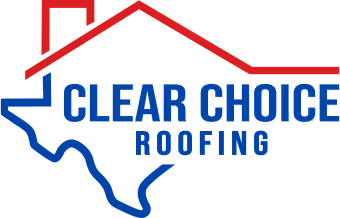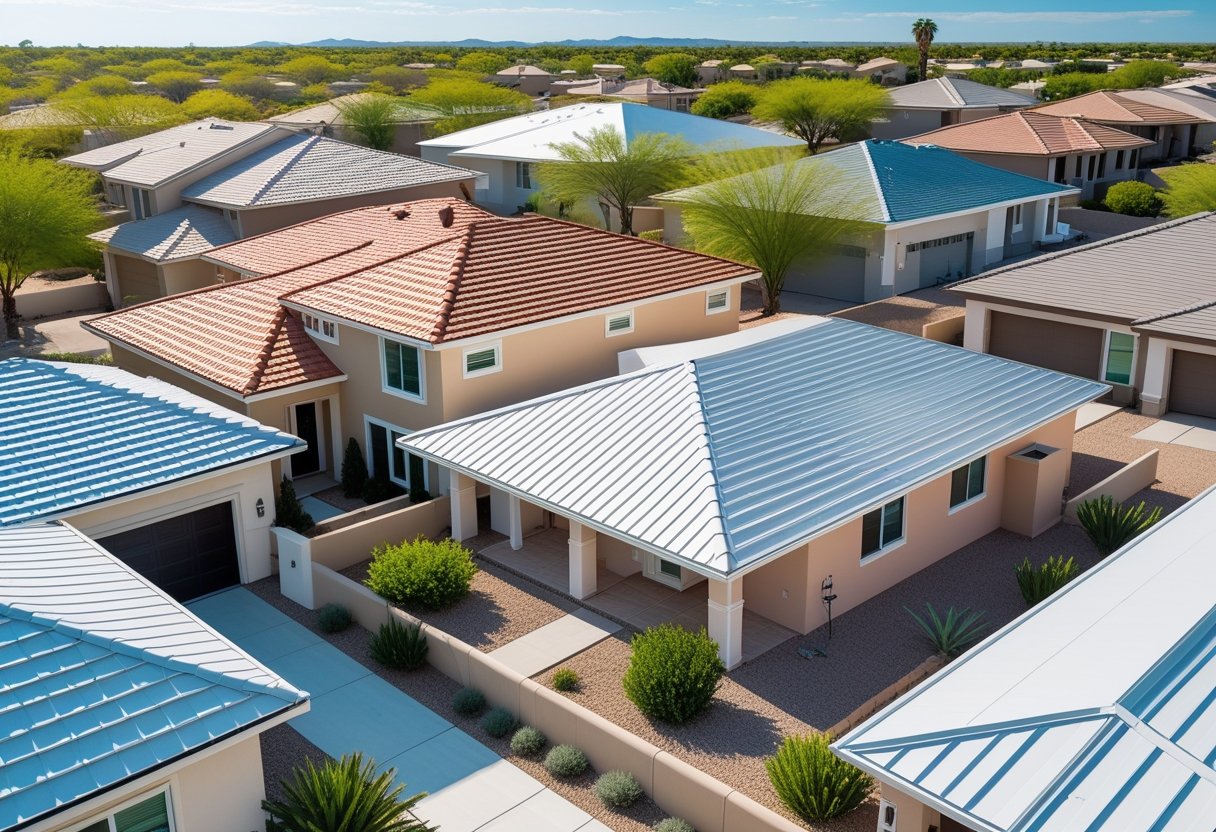Choosing the right roof color can make a real difference in keeping your home cool and cutting down those energy bills, especially if you live somewhere hot. Light colors like white, beige, and light gray bounce sunlight away better than dark colors, so your house stays cooler during those brutal summer months. You might notice your air conditioner doesn’t have to work as hard.
Metal roofs are a solid choice for energy efficiency because they reflect more heat than shingle roofs, which tend to soak up heat and drive up cooling costs. At Clear Choice Roofing, we’ll help you sort through materials and colors that fit your budget and keep your home comfortable.
If you want to save money and stay cool under the Texas sun, knowing which roof colors actually help is key. Let’s dive into how you can make a smarter choice for your roof—and your wallet.
How Roof Color Impacts Energy Efficiency
Your roof’s color changes how much heat your home soaks up or bounces back. The right color can keep your house cooler and lower your energy bills, especially when it’s blazing outside. Some colors and materials just work better for managing heat and making your space feel livable.
Solar Reflectance and Heat Absorption
Solar reflectance is basically how much sunlight your roof sends packing instead of soaking in. Light-colored roofs—think white, beige, or light gray—do a great job reflecting sunlight. That means your home stays cooler on hot days.
Darker roofs, like black or deep brown, pull in more heat, warming up your roof and cranking up indoor temps. That can make your AC work overtime, using more energy.
We usually recommend lighter colors for homes in Austin and other warm spots. A roof with high solar reflectance lets you cut cooling costs and stay more comfortable in the summer.
The Science Behind Cool Roofs
Cool roofs are designed to keep heat at bay by reflecting sunlight and letting go of heat quickly. They use special paint or materials to boost reflectance and drop heat absorption.
If you go with a cool roof, your home doesn’t heat up as much, so your AC doesn’t have to run as long. That’s money saved on electricity.
Cool roofs tend to be lighter in color, but some newer products add cooling features to darker shades, too. So, if you’re not into bright white, you’ve got options for energy savings.
Thermal Emissivity Explained
Thermal emissivity is about how fast your roof can get rid of the heat it’s picked up. A roof with high emissivity cools down faster when the sun sets, so heat doesn’t stick around all night.
Roofs with low emissivity trap heat longer, which can make your house stay warm even after sunset. In hot places, you want a roof with both high reflectance and high emissivity for the best cooling.
When you talk to Clear Choice Roofing, ask about materials that balance both. That way, your roof actually protects you from the Texas heat, not just sits up there looking pretty.
Top Energy-Efficient Roof Colors for Hot Climates
Picking the right roof color can really cut down on heat inside your home. Light-colored roofs and reflective coatings help keep heat out, which means you stay cooler and spend less on energy.
Benefits of Light-Colored Roofs
Light colors reflect most of the sunlight, so your roof doesn’t get as hot. That makes a difference during those scorching days. With a lighter roof, you won’t need the air conditioning as much, which is always good for your wallet.
On top of that, light roofs can extend the life of your roofing materials. Overheating can wear out shingles faster, and dark roofs soak up more heat, which doesn’t help.
If you’re in a hot climate, a light color like beige, light gray, or pale brown can make your home noticeably more comfortable and lower your bills.
White and Off-White Roofing Options
White and off-white roofs are some of the best for reflecting sunlight. They send most solar rays right back, so less heat gets into your house.
You can get white metal roofing or coated shingles designed to keep your place cooler. These shades are especially helpful in sunny spots like Texas.
White roofs lower cooling costs and can even boost your home's overall energy efficiency. Pair them with good attic insulation to keep your inside temps steady.
Reflective Pigments and Advanced Coatings
Some roofing materials now come with reflective pigments or special coatings. They’re made to reflect sunlight and release heat quickly.
These don’t have to be plain white—some come in other colors and still do a solid job keeping heat out. You can apply reflective coatings to metal, tile, or even asphalt shingles to give them a performance boost.
Using these advanced materials can cut your cooling bills and help your roof last longer. Clear Choice Roofing can walk you through options with these features that fit your place and your budget.
Comparing Popular Roof Materials and Colors
Your choice of roof material and color really matters for staying cool in hot weather. Some materials handle heat better, and certain colors reflect sunlight to keep heat from building up. Here’s a look at metal, tile, and asphalt roofing to help you figure out what’s best for your home.
Metal Roofing Choices for Heat Reduction
Metal roofs are excellent for hot climates—they reflect sunlight well, especially if you go with a reflective paint. Lighter colors like white, silver, or light gray are best for cutting heat absorption.
Metal roofing is tough, too. It stands up to storms, wind, and hail, which is great if you get wild weather. Its smooth surface lets rain and debris slide off, so your roof stays cleaner.
If you want a roof that keeps energy costs down and handles tough weather, metal is worth a look. Clear Choice Roofing knows how to install metal roofs to get the most out of them in Austin’s heat.
Tile Roofs: Colors and Performance
Tile roofs offer lots of color choices, but lighter shades like beige, cream, or light terracotta reflect heat better than darker reds or browns. Ceramic and concrete tiles do well under the sun, and they let air flow beneath them, which keeps your home cooler.
Tile is heat-resistant and lasts a long time without warping or fading, but it’s heavier and costs more than metal or asphalt. If your house can handle the weight, tile can look great and save energy.
Choosing the right tile color is important—even a small change can drop your cooling bills by reflecting more sunlight.
Asphalt Shingles: Lighter Shades vs. Traditional Colors
Asphalt shingles are common and pretty affordable, but the color matters for energy efficiency. Dark shades like black or brown soak up more heat, which makes your home warmer.
Light-colored shingles—like light gray or tan—reflect more sunlight and can drop attic temps by several degrees. Some brands now offer "cool roof" shingles that reflect UV rays better.
If you go with asphalt, pick lighter shades to help keep your house cooler. Clear Choice Roofing can help you find choices that handle your local weather and save energy.
Choosing The Right Roof Color for Your Home
Choosing the best roof color really does matter—it affects how much heat your home absorbs and how it looks from the street. The right shade keeps your house cooler in hot places and can match your style or neighborhood vibe.
Climate and Regional Considerations
In hot spots, light-colored roofs work best—they reflect sunlight and heat. Shades like white, beige, light gray, and soft pastels help cut cooling costs by keeping your home cooler. Dark colors, like black or chocolate brown, just soak up the heat.
If you’re somewhere with tons of sun, a reflective roof color also protects your roofing materials from heat damage. Metal roofs with light paint reflect even more heat than shingles, so your home stays comfortable longer.
Aesthetics and Architectural Styles
Your roof color should fit your home’s style and the look of your neighborhood. For example, beige or soft brown looks great on a traditional or Southwestern house. Modern homes often look good with gray or slate.
Think about your wall color and landscaping, too. Matching or complementing these can make your home look balanced and inviting.
If you’re not sure what works, Clear Choice Roofing can help you sort through the options for your home and climate.
Maintenance Tips for Energy-Efficient Roof Colors
A roof that keeps your home cool and looks good needs some regular TLC. A few simple habits—like cleaning and protecting the color—will help your roof stay cool and last longer in the sun.
Cleaning and Upkeep
Clean your roof shingles now and then to get rid of dirt, moss, or algae. These can create dark spots that soak up heat and reduce your roof’s ability to reflect sunlight.
Use a soft brush or a low-pressure washer—high-pressure washes can mess up shingles. Mild cleaning solutions made for roofs work best; harsh chemicals can fade the color or eat away at your roofing.
Try to inspect your roof twice a year. Clear away leaves or branches that block airflow and trap heat.
Longevity and Color Retention
To keep your roof’s color bright and working well, protect it from damage. Sun, heat, and weather can wear down pigments over time, so a little care goes a long way.
Applying a roof sealant or reflective coating helps slow fading and boosts energy savings by reflecting more sunlight.
Fix cracks or loose shingles as soon as you spot them. Water can sneak in and cause mold, which darkens the roof and makes your home hotter.
At Clear Choice Roofing, we use materials that hold their color and perform well in Texas heat. Taking care of your roof extends its life and keeps your energy bills down.
Environmental and Cost Benefits of Energy-Efficient Roof Colors
Choosing the right roof color can mean real savings on energy bills. Light colors reflect sunlight, which helps your home stay cooler in hot weather. You won’t need to crank the AC as much, so you use less electricity.
Dark roof colors pull in heat and drive up indoor temps, which means higher cooling costs and more wear on your AC. Using energy-efficient colors means you spend less on power and your cooling system doesn’t have to work as hard.
Energy-efficient roof colors also make a difference for the environment. Less energy use means fewer greenhouse gas emissions. That helps fight climate change and keeps the air a bit cleaner. It’s a small step, but you’re doing your part just by picking a good roof color.
Here’s a quick comparison of common roof colors and their benefits:
Roof ColorEnergy EfficiencyCost ImpactEnvironmental Impact White or LightHigh solar reflectanceLower cooling billsLess energy use, fewer emissionsMedium ShadesModerate reflectanceModerate costsModerate benefitDark ColorsLow reflectanceHigher cooling billsMore energy use, more emissions
Clear Choice Roofing can help you pick colors that fit your home and save energy. Choosing energy-efficient roofing is a smart move for your wallet and the planet.
Common Mistakes to Avoid When Selecting Roof Colors
Picking a roof color for energy efficiency in hot climates isn’t always straightforward. A common mistake: choosing a dark color without thinking about how much heat it’ll soak up. Dark roofs pull in more heat, which means higher cooling bills and a less comfortable house.
People sometimes ignore how reflective the roofing material is. Even light colors can differ a lot in how well they bounce heat away. You want a color and material combo that reflects sunlight well to keep your home cooler.
Don’t pick a color just because it looks good. Sure, curb appeal matters, but if you don’t consider energy efficiency, you could end up paying more every month. Try to balance looks with energy-saving features.
Trendy colors can be tempting, but some fade quickly under strong sun. Fading can mess with how well your roof reflects heat over time. Durable, fade-resistant colors help your roof keep doing its job longer.
Also, watch out for colors that clash with your home’s look or neighborhood style. That can hurt your property value. Clear Choice Roofing can help you find something that fits your home and saves energy.
And really, don’t skip professional advice. Roof color affects more than just looks, and you want someone experienced in your corner. Clear Choice Roofing offers expert guidance to help you pick the best option for your climate and style.
Remember these tips:
- Avoid very dark colors in hot climates
- Look for high reflectivity, not just light shades
- Choose fade-resistant colors
- Match your home’s overall look
- Get expert advice before deciding
That way, your roof stays cooler, and your bills don’t get out of hand.
Frequently Asked Questions
Picking the right roof color really can change how your home handles the heat. Some shades bounce sunlight away and keep things cooler, while others just soak it all up.
What shades of roof material offer the most energy savings in hot regions?
Lighter colors like white, cream, or light gray bounce more sunlight off your roof. That means less heat sneaks inside, so your house stays cooler.
How does roof color impact the energy efficiency of a home?
When you go with a dark roof, it grabs onto heat and makes your attic—and the rest of your place—warmer. Then your AC has to work overtime, and you’ll see it on your energy bill.
Are there specific roof colors that are better for hotter climates?
For sure. If you live somewhere hot, try cool roof colors with reflective granules—think light browns or soft tans. They reflect sunlight but don’t look too flashy or out of place.
Can the color of your roof shingles affect your home's cooling costs?
Definitely. Lighter-colored shingles reduce heat buildup, so your cooling system doesn’t have to work as hard.
What should be considered when choosing a roof color for high heat exposure?
Look at how well the color reflects sunlight and whether it matches your home’s vibe. If you spot materials labeled as "cool roof" products, those are made to help with energy efficiency.
Does a roof color's reflectivity contribute to overall energy efficiency?
Absolutely. When your roof reflects more sunlight, it stays cooler. That means your home absorbs less heat, which can really help cut down on cooling costs if you live somewhere hot.
Not sure which roof color makes sense for your place? Clear Choice Roofing can walk you through the options and handle installation that stands up to the Texas sun.



